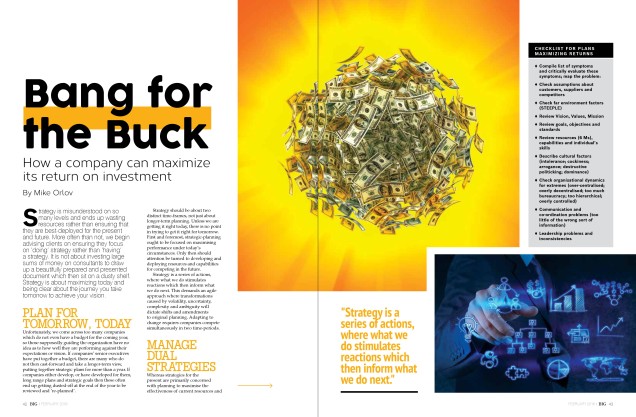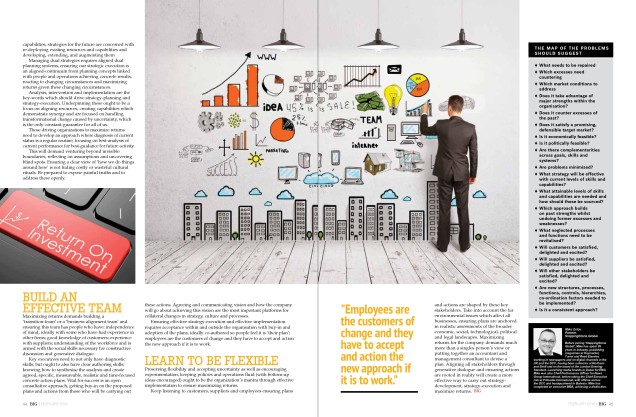Strategy is misunderstood on so many levels and ends up wasting resources rather than ensuring resources are best-deployed for the present and the future. More often than not, we begin advising clients on ensuring they focus on ‘doing’ strategy rather than ‘having ‘a strategy. It is not about investing large sums of money on consultants to draw up a beautifully prepared and presented document which then sit on a dusty shelf. Strategy is about maximizing today and being clear about the journey you take tomorrow to achieve your vision.
Unfortunately we come across too many companies which do not even have a budget for the coming year, so those supposedly guiding the organization have no idea as to how well they are performing against their expectations or vision. If companies’ senior executives have put together a budget, there are many who do not then cast-forward and take a longer-term view, putting together strategic plans for more than a year. If companies either develop, or have developed for them, long range plans and strategic goals then these often end up getting dusted-off at the end of the year to be reviewed and ‘re-planned’.
Strategy should be about two distinct time-frames, not just about longer-term planning. Unless we are getting it right today, there is no point in trying to get it right for tomorrow. First and foremost, strategic-planning ought to be focused on maximising performance under today’s circumstances. Only then should attention be turned to developing and deploying resources and capabilities for competing in the future.
Strategy is a series of actions, where what we do stimulates reactions which again inform what we next do. This demands an agile approach where transformations caused by volatility, uncertainty, complexity and ambiguity will dictate shifts and amendments to original planning. Adapting to change requires companies compete simultaneously in two time-periods.
Whereas strategies for the present are primarily concerned with planning to maximise the effectiveness of current resources and capabilities, strategies for the future are concerned with re-deploying existing resources and capabilities and developing, extending, and augmenting them
Managing dual strategies requires aligned dual planning systems, ensuring our strategic execution is an aligned-continuum from planning concepts linked with people and operations achieving concrete results, reacting to changing circumstances and maximizing returns given these changing circumstances.
Analysis, intervention and implementation are the key-words which should drive strategy-planning and strategy-execution. Underpinning these ought to be a focus on aligning resources, creating capabilities which demonstrate synergy and are focused on handling transformational change caused by uncertainty, which is the only constant-guarantee for all of us.
Those driving organizations to maximize returns need to develop an approach where diagnosis of current status is a regular routine, focusing on best-analysis of current performance for best-guidance for future activity. This will demand venturing beyond invisible boundaries, reflecting on assumptions and uncovering blind spots. Ensuring a clear view of ‘how we do things around here’ is not hiding costly or wasteful cultural rituals. Be prepared to expose painful truths and to address these openly.
Maximizing returns demands building a ‘transition-team’ or a ‘business-alignment team’ and ensuring this team has people who have: independence of mind, ideally with some who have had experience in other firms; good knowledge of customers; experience with suppliers; understanding of the workforce and is armed with the social skills necessary for constructive discussion and generative dialogue.
Key executives need to not only have diagnostic skills, but ought to also have clear authoring skills; knowing how to synthesise the analysis and create agreed, specific, measureable, realistic and time-focused concrete action plans. Vital for success is an open consultative approach, getting buy-in on the proposed plans and actions from those who will be carrying out these actions. Agreeing and communicating vision and how the company will go about achieving this vision are the most important platforms for collateral changes in strategy, culture and processes.
Ensuring effective strategy-execution and effective implementation requires acceptance within and outside the organisation with buy-in and adoption of the plans, ideally co-authored so people feel it is ‘their plan’; employees are the customers of change and they have to accept and action the new approach if it is to work.
Preserving flexibility and accepting uncertainty as well as encouraging experimentation, keeping policies and operations fluid (with bottom-up ideas encouraged) ought to be the organization’s mantra through effective implementation to ensure maximizing returns.
Keep listening to customers, suppliers and employees ensuring plans and actions are shaped by these key stakeholders. Take into account the far environmental issues which affect all businesses, ensuring plans are anchored in realistic assessments of the broader economic, social, technological, political and legal landscapes. Maximizing returns for the company demands much more than a singles person’s view or putting together an accountant and management consultant to devise a plan. Aligning all stakeholders through generative dialogue and ensuring actions are rooted in reality will create a more effective way to carry out strategy-development, strategy-execution and maximize returns.
CHECKLIST FOR PLANS MAXIMIZING RETURNS
Compile list of symptoms and critically evaluate these symptoms; map the problem:
Check assumptions about customers, suppliers and competitors
Check far environment factors (STEEPLE)
Review Vision, Values, Mission
Review goals, objectives and standards
Review resources (6 Ms), capabilities and individual’s skills
Describe cultural factors
(intolerance; cockiness; arrogance; destructive politicking; dominance)
Check organisational dynamics for extremes
(over-centralised; overly decentralised; too much bureaucracy; too hierarchical; overly controlled)
Communication and co-ordination problems (too little of the wrong sort of information)
Leadership problems and inconsistencies
The map of the problems should suggest:
- What needs to be repaired
- Which excesses need countering
- Which market conditions to address
- Does it take advantage of major strengths within the organisation?
- Does it counter excesses of the past?
- Does it satisfy a promising, defensible target market?
- Is it economically feasible?
- Is it politically feasible?
- Are there complementarities across goals, skills and systems?
- Are problems minimised?
- What strategy will be effective with current levels of skills and capabilities?
- What attainable levels of skills and capabilities are needed and how should these be sourced?
- Which approach builds on past strengths whilst undoing former excesses and weaknesses?
- What neglected processes and functions need to be revitalised?
- Will customers be satisfied, delighted and excited?
- Will suppliers be satisfied, delighted and excited?
- Will other stakeholders be satisfied, delighted and excited?
- Are new structures, processes, functions, controls, hierarchies, co-ordination factors needed to be implemented?
- Is it a consistent approach?




